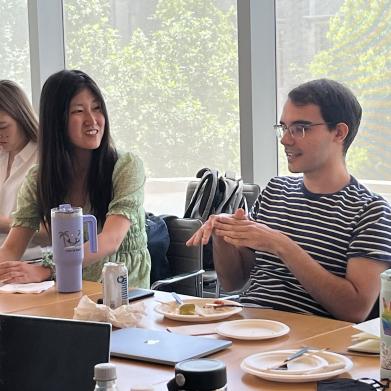| Time | Event | Details |
|---|---|---|
| 09:00am - 09:40am | Breakfast |
Welcome with David Lee, acting director of the Industrial Relations Section |
| 09:45am - 10:15am | School of Hard Knocks: Violent Conflict and Educational Attainment in Egypt |
Akash Uppal, Yale University |
| 10:15am - 10:35am | Judicial Selection and State Finances |
Alicia Liu, Stanford University |
| 10:35am - 10:55am | Tax-induced migration: Economic effects of a foreigners’ tax scheme in France |
Pauline Kermoal, Princeton University |
| 10:55am - 11:15am | Economic Mobility and Fairness in a Developing Country: Evidence from Peru |
Joaquin Armas Muguerza, Princeton University, Universidad del Pacifico |
| 11:15am - 11:30am | Informational Linkages and Stock Market Comovement |
Hriday Karnani, Columbia University |
| 11:30am - 11:45pm | Stance Detection in 19th Century Newspapers: Morrill Tariff and the Civil War |
Yifan He, Yale University
|
| 11:45am - 12:45pm | Lunch |
|
| 12:45pm - 01:15pm | The Gender Diversity Gap in Mathematics |
Francine Montecinos, Columbia University |
| 01:15pm - 01:35pm | Migration, Banking, and Gender: Do Remittances Impact Women’s Access to Credit? |
Josefina Silva, The World Bank Group
|
| 01:35pm - 01:55pm | Who's Better Off Alone? Equity Consequences of Endogenous Polity Formation |
Cedric Christensen, Princeton University |
| 01:55pm - 02:15pm | Estimating the Impact of Minimum Wage Policies on Worker Outcomes in the U.S. Service Sector, 2016–2024 |
Henri Jackson, Havard Kennedy School |
| 02:15pm - 02:30pm | The Effects of Housing Prices on Fertility |
Göksu Zeybek, Yale University |
| 02:30pm - 02:45pm | Long Run Consequences of Ethnic Conflict on Social Capital: Evidence from South Africa |
Santiago Paz, Stanford University |
| 02:45pm - 03:00pm | Break |
|
| 03:00pm - 03:30pm | Rising Markups in the Banking Industry |
Sofia Arredondo, Central Bank of Chile |
| 03:30pm - 03:50pm | Racial Inequality in the U.S.: Combined vs. Market Wealth |
Niklas Hein, Princeton University |
| 03:50pm - 04:10pm | Chinese Macroeconomic Surprises and The Global Financial Cycle |
Camila Andrea Gutierrez Ramirez, International Monetary Fund |
| 04:10pm - 04:30pm | U.S. Regulatory Delays in Construction Across Time |
Sam Barnett, Princeton University |
| 04:30pm - 04:45pm | The Efficacy of Artificial Intelligence in Combating Crime: An Empirical Analysis of ShotSpotter in Chicago |
Esther Sanchez, Chicago Booth
|
| 04:45pm - 05:00pm | Technological Change and Social Norms: Evaluating the Impact of the Green Revolution on Child Marriage in India |
Ann Yang, University of Michigan |

May 16 at 9:45AM
School of Hard Knocks: Violent Conflict and Educational Attainment in Egypt
Akash Uppal
Yale University
Abstract
The months after 2011's Egyptian revolution tested democracy. While it eventually prevailed, the interim period saw widespread violence against civilians prompt political instability. This paper quantifies the impact of violent conflict on educational attainment by exploiting temporal and spatial variation in exposure to violence. Comparing birth cohorts whose schooling decisions were unaffected by the onset of conflict to those of mandatory schooling age in 2011 across high- and low-conflict intensity regions, I find a one standard deviation increase in regional conflict intensity causes a 0.4-year reduction in schooling completed. Robustness checks, including alternative specifications and a placebo test, as well as evidence in favor of identifying assumptions, are presented. For a country with over half the population under age 25, understanding the impact of violence on education is critical for designing policies to mitigate long-term negative impacts on affected students.

May 16 at 10:15AM
Judicial Selection and State Finances
Alicia Liu
Stanford University
Abstract
This project explores the relationship between how a state selects its judges and state government spending. Every US state (except for Vermont) has a balanced budget rule (BBR), and economists have long studied the effects of these laws, whether by limiting a state’s stimulus response during a recession or preventing insolvency issues. Because taxpayers have standing to sue state governments for violations of BBRs, this makes state courts of last resort, more commonly referred to as “state supreme courts,” an enforcer of state fiscal discipline.
Generally, justices can either be appointed, selected by a nominating commission, or directly elected. This project will use plausibly exogenous changes in judicial selection from the 1990s to the 2010s to examine the causal effect of selection systems on state government spending, with a particular focus on politically contentious forms of spending such as education and welfare benefits.

May 16 at 10:35AM
Tax-induced migration: Economic effects of a foreigners’ tax scheme in France
Pauline Kermoal
Princeton University
Abstract
Preferential tax schemes offering foreigners reduced top tax rates are increasingly used as an instrument to attract high-skill workers from other countries. Their effects on migration behaviors are well documented, but evidence of their implications for economic activity remains scarce. This paper will investigate the economic effects of offering foreign top earners a preferential tax regime. Leveraging variations in tax rate and exemption duration created by reforms of the French scheme in 2008 and 2017, it will study individuals’ migration responses and labor- and capital-market behaviors, as well as firm-level outcomes for the firms hiring foreign high-income workers. In doing so, this paper will uncover the aggregate economic implications of preferential tax schemes for foreigners, which is crucial given the substantial fiscal burden and potential political costs that they entail.
May 16 at 10:55AM
Economic Mobility and Fairness in a Developing Country: Evidence from Peru
Joaquin Armas Muguerza
Princeton University, Universidad del Pacifico.
Abstract
For the 2002–2016 period, we study intragenerational mobility using longitudinal data from the Young Lives Project in Peru. We find a moderate degree of economic mobility using an asset-based wealth measure to rank households in each survey round, with one-third of households experiencing shifts of at least twenty percentile ranks. However, averages mask heterogeneity across groups. We find a positive mobility gap of 12 percentiles in favor of native Spanish-speaking households relative to those that speak only an indigenous language—half of which persists after controlling for a comprehensive set of characteristics. We propose a novel measure of household-level mobility and use it to normatively assess the degree of inequality of opportunity for mobility. The share of mobility attributable to circumstances beyond households’ control is at least 17% for the poorest half of the sample, but only 2% for the richest half.

May 16 at 11:15AM
Informational Linkages and Stock Market Comovement
Hriday Karnani
Columbia University
Abstract
I empirically study how excess comovement in stock returns can be explained by stock-to-stock interdependence through informational links. Informational linkages emerge from anomalous interdependence in agents' beliefs about stocks' economic performance. I propose a novel measure for informational linkages based on agents' learning process, which is biased towards common information due to learning frictions, generating correlated beliefs across stocks. I empirically measure these correlated beliefs based on analysts' forecast errors. Results show that informational connections explain stock returns after cleaning for fundamental connections and controlling for various explanations already studied in the literature. I use the estimated informational linkages to study the propagation of a climate event and simulated shocks through the stock market, finding quantitatively important indirect effects.

May 16 at 11:30AM
Stance Detection in 19th Century Newspapers: Morrill Tariff and the Civil War
Yifan He
Yale University
Abstract
This study investigates public opinion on the 1861 Morrill Tariff, utilizing a technique called “stance detection” to analyze digitized newspaper archives from the Library of Congress’ Chronicling America database. The Morrill Tariff marked a shift toward protectionism in U.S. trade policy, coinciding with the Civil War and provoking strong regional divides—particularly opposition from the South. We use this as a test case to examine the viability of historical stance detection for understanding public opinion at a state and county level to see whether it is possible to understand the interplay between public discourse and political decision-making in more detail. We also aim to investigate diffusion mechanisms, such as cross-quoting among newspapers.
We use different VLM and LLM based approaches to treat the scans from the Library of Congress, identify articles and stances and assign locations. The outcome is a dataset that categorizes relevant newspaper excerpts as in favor, against, or neutral regarding the Morrill Tariff. Findings reveal – unsurprisingly – that political alignment significantly influenced newspaper stances, with Republican-leaning sources expressing stronger support. Southern publications, impacted by the tariff’s economic consequences, overwhelmingly opposed it.
As a preliminary result, we plot the regional distribution and polarization of stances on (protectionist) tariff reform between 1857 – then the so-called ‘panic of 1857’ renewed protectionist tendencies – and 1861, when the Morrill Tariff became law and the Civil War began. We then explore whether regional patterns of opposition to the protectionist tariff (as a form of federal taxation) reveal insights into a long-standing argument whether questions of taxation and trade policy contributed to secessionist tendencies in the South. We explore whether it is possible to econometrically separate the anti-abolitionist and the anti-tariff motivation for secession to understand the link between trade policy debates and the civil war.
Note that this project is still in a preliminary stage, especially regarding the implementation of testing for the link between trade policy and secession. We do, however, have a rich dataset of regional stances on trade policy and its relations to criticizing the government and individual political actors, as well as discursive links to the abolition conflict, on file.

May 16 at 12:45PM
The Gender Diversity Gap in Mathematics
Francine Montecinos
Columbia University
Abstract
Using administrative data, test scores, and surveys, this paper examines gender gaps in mathematics performance and confidence among cisgender, transgender, and non-binary 10th-grade students in Chile. Employing a Generalized Boosted Model matching approach for multiple treatments and accounting for baseline scores and confidence levels from 4th grade, we identify significant disparities. Cisgender women, transgender students, and non-binary AFAB (assigned female at birth) students demonstrate gaps compared to cisgender men in both confidence and scores. Moreover, transgender and non-binary students experience higher rates of discrimination and social media aggression, which negatively impact their mathematics outcomes. Sexual orientation discrimination correlates negatively with mathematics confidence, explaining approximately 35-40% of the observed gap for transgender and non-binary students. Quantile regression analyses reveal that performance gaps widen at higher achievement levels for AFAB students while narrowing for transgender women.

May 16 at 1:15PM
Migration, Banking, and Gender: Do Remittances Impact Women’s Access to Credit?
Josefina Silva
The World Bank Group
Abstract
Do remittances affect women’s access to credit in developing economies? Using unique data from bank branches in Honduras, we analyze the impact of regional remittance flows on credit balances by gender. Following the COVID-19 pandemic, remittances surged amid reduced economic activity, revealing a credit reallocation favoring male borrowers, especially in less-developed regions with weak financial systems and larger gender income gaps. These findings suggest that financial frictions in developing economies can exacerbate the gender gap in financial inclusion during remittance-driven liquidity booms.

May 16 at 1:35PM
Who's Better Off Alone? Equity Consequences of Endogenous Polity Formation
Cedric Christensen
Princeton University

May 16 at 1:55PM
Estimating the Impact of Minimum Wage Policies on Worker Outcomes in the U.S. Service Sector, 2016–2024
Henri Jackson
Havard Kennedy School
Abstract
In recent years, the minimum wage policy landscape in the United States has undergone a significant transformation, marked by the widespread adoption of regular increases at the state level. While the existing literature has predominantly focused on employment effects, comparatively less is known about how minimum wage increases affect other dimensions of job quality, particularly since national data rarely directly observe workplace characteristics.
Our research aims to address this gap by leveraging data from the Shift Project, a nationally representative panel survey of service-sector workers conducted between 2016 and 2024. The Shift Project uniquely captures detailed information on workers’ schedules, job conditions, and perceptions of workplace change, enabling a rare look into how employers adjust along non-wage margins. To identify causal effects, we employ a stacked difference-in-differences design that exploits the staggered implementation of minimum wage increases across states and over time. Our preliminary findings highlight minimum wage effects on various channels of adjustment—work scheduling outcomes, access to employer-provided benefits, and employer responses via automation—contributing to the evidence on the distributional and organizational consequences of minimum wage policy.

May 16 at 2:15 PM
The Effects of Housing Prices on Fertility
Göksu Zeybek
Yale University

May 16 at 2:30PM
Long Run Consequences of Ethnic Conflict on Social Capital: Evidence from South Africa
Santiago Paz
Stanford University
Abstract
This paper studies the following research question: What are the consequences of historical ethnic conflict on contemporary levels of social capital? This question is relevant, since understanding the consequences of historical ethnic violence on contemporary social capital can provide useful inputs to design effective State-building policies. I exploit Mfecane, a period of ethnic upheaval in South African history, as a setting to examine the causal effects of historical ethnic conflict on contemporary levels of social capital. For this end, I use a combination of a historical approximation of the Mfecane warzone with geocoded data from the Afrobarometer project (2000-2016). Using an instrumental variables strategy, I find that historical ethnic conflict decreases contemporary trust in people among individuals living within the borders of Mfecane, while increasing trust in relatives and neighbors. Increases in 'in-group' trust appear to be driven by the long-run persistence of parochial altruism. Conversely, lower levels of 'between-group' trust can be explained by the lack of economic incentives to cooperate with strangers in former warzones. Furthermore, I find that group selection dynamics are partially driving these differential effects by fostering group-based affect and intergroup prejudice among contemporary descendants of historically conflicting groups. These results are suggestive of a degree of substitutability between in-group and between-group social capital at the community level.

May 16 at 3:00PM
Rising Markups in the Banking Industry
Sofia Arredondo
Central Bank of Chile
Abstract:
Market power is a fundamental concept in Industrial Organization (IO), as it defines the field. Markups serve as indicators of market power. The IO literature has traditionally focused on specific situations and moments in time, rather than the evolution of market power (Miller, 2024; De Loecker et al., 2020). There is increasing documentation of rising markups in various industries, such as cereals, concrete, and airlines (Miller, 2024). However, empirical literature on markups in credit markets remains scarce.
Higher market power can negatively impact consumer surplus and increase the probability of collusion. Conversely, lower market power can lead to reduced prices, greater innovation in financial products, and enhanced financial stability (Repullo, 2024).
We fill the gap in the literature by estimating markups in the Chilean credit market. Utilizing confidential bank data at the loan level, we estimate the demand and supply for commercial loans. Our approach involves developing a structural model where we include borrowers’ choice, loan amount and probability of repayment. We recover estimates for elasticities, marginal costs, and markups.
Our findings indicate that market power has increased by an average of 12% over the sample period (2013-2019). Markups observed for smaller firms are approximately 17% larger. Meanwhile, marginal costs have decreased by 3% throughout the study period.
We discuss and examine potential mechanisms underlying our findings, namely, firms becoming less price-sensitive over time, and increased concentration in the market. We show that firms' price elasticity has decreased by 8% in our sample period.

May 16 at 3:30 PM
Racial Inequality in the U.S.: Combined vs. Market Wealth
Niklas Hein
Princeton University
Abstract
Prior research on racial wealth inequality using expanded measures of wealth has focused on recent decades covered by the modern SCF waves. My master's thesis extends the literature by constructing the first long-run time series of the white-to-black Social Security Wealth (SSW) and combined wealth (market + SSW) gap, spanning the period from 1950 to 2019.
May 16 at 3:50PM
Chinese Macroeconomic Surprises and The Global Financial Cycle
Camila Andrea Gutierrez Ramirez
International Monetary Fund
Abstract
We study the international spillover effects of a macroeconomic surprise in China.
Using high-frequency data, we compute a novel series of macroeconomic surprises in China as the difference between the released and expected values of a variable. The surprise component of the release of macroeconomic data in China brings a sizeable and
synchronized effect on global risk and asset prices across different economies. The effect of Chinese macroeconomic surprises on asset prices is comparable on impact to that of US macroeconomic surprises but smaller than US monetary policy. We document that
the predominant channel differs between these surprises. While US macro surprises reflect expected growth, agents are willing to take more risk in response to a positive Chinese macroeconomic surprise which we interpret as Hedging Premium.

May 16 at 4:10PM
U.S. Regulatory Delays in Construction Across Time
Sam Barnett
Princeton University
Abstract
Existing measures of the stringency of U.S. land use regulations are snapshots in time. To study the relationship between administrative barriers and housing affordability, I use permit-level data to construct a novel dataset of average annual delays for new residential construction permits in 25 U.S. cities across up to 40 years. Average delays correlate with the composite measure of restrictiveness from the 2018 Wharton Regulatory Land Use Survey Initiative (WRLURI). Furthermore, increases in the WRLURI between its 2006 and 2018 iterations are associated with increases in delays over the same time period, suggesting that delays capture variation in regulation across time. Delays also correlate closely with house prices and with personal income. Using a local projection specification with city fixed effects, a one-day increase in delays is estimated to increase house prices eight years later by $750. The above results are significant at the 0.05 level.

May 16 at 4:30PM
The Efficacy of Artificial Intelligence in Combating Crime: An Empirical Analysis of ShotSpotter in Chicago
Esther Sanchez
Chicago Booth
Abstract
This paper examines the impact of ShotSpotter, an artificial intelligence-powered gunshot detection system, on crime outcomes in Chicago. ShotSpotter has been a focal point of controversy, with proponents emphasizing its potential to improve police response times and critics highlighting its role in over-policing Black and Latino communities. Using public crime data from the Chicago Police Department from 2001 to 2025, this study employs a staggered difference-in-differences model to evaluate ShotSpotter’s effectiveness in reducing gun violence, increasing arrests, and improving clearance rates.
May 16 at 4:45PM
Technological Change and Social Norms: Evaluating the Impact of the Green Revolution on Child Marriage in India
Ann Yang
University of Michigan, incoming research assistant at the Federal Reserve Bank of Chicago
Abstract
What effect did agricultural technology implementation during the Green Revolution have on child marriage rates for women in India? Exploiting exogenous variation in the global rollout of high-yielding variety (HYV) seeds, I provide evidence that higher agricultural productivity increased the likelihood of early marriage. With stronger effects observed in credit-constrained households, I suggest that this increase likely results from the dowry effect prevailing over the income effect brought upon by the Green Revolution. These results underscore the importance of comprehensive policy design that examines the potential negative spillover effects of well-intentioned national initiatives.


